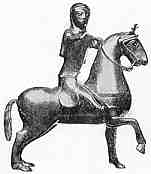



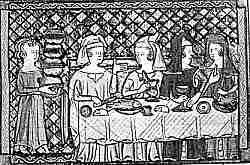
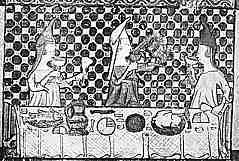

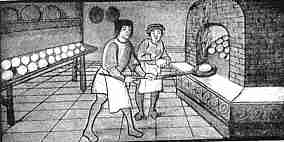
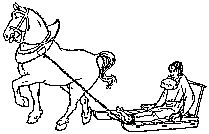
If you are looking at this page without frames, there is more information about medieval writing to be found by going to the home page (framed) or the site map (no frames).
| Works on Food and Cookery (2) | |||||
 |
The nature of the grand meal as an occasion for competitive social display is demonstrated by the survival of numerous elaborate table accessories, including ewers, jugs, cups and salt cellars, which the socially favoured sat above, not below, at the long trestle table. |  |
|||
| Above, a 14th century bronze ewer in the form of a mounted horseman; at right a silver mazer bowl of around 1480 from Pembroke College, Cambridge. | |||||
| While written works specifically devoted to cooking and dining may be largely devoted to the upper social strata of the later middle ages, and a particular aspect of their eating as a social event, there are many other ways to find out about food in medieval society from manuscript sources. For one thing, it is much depicted pictorially. | |||||
 |
|||||
| Duke William and his troops enjoy a feed on the Bayeux Tapestry. Yes, it is a manuscript, of sorts. | |||||
 |
A dining scene from an Anglo-Saxon manuscript. | ||||
| The assorted dishes on the table, meat served on skewers, the trencher bread and each diner's personal knife obviously had a long history, as also did the retainers serving food while carefully keeping themselves on a lower level to the diners. As for the food, it was probably simpler then. | |||||
| By the later middle ages, trade had brought an increasing array of spices and other exotic ingredients to the marketplaces, where they were available to a broader spectrum of the population. The bourgeois of the towns were able to enter the competitive arena with food preparation and display, as they did in other areas of social competition. Fancy cooking spread wider across the social spectrum, and perhaps those recipe books served a function here, although characteristically the recipes did not contain truly detailed instructions or quantities. As with building cathedrals, the details resided within the heads of the experts. | |||||
 |
 |
||||
| Two images from a 14th century book of fabliaux, that at left representing a bourgeois dining table, while that at right shows three women dining, or at least wining, in a tavern (Arsenal, ms 3525). (From Bédier and Hazard 1923) | |||||
| A fabliau was a humourous and satirical story which often related to the doings of the bourgeoisie. According to the source from which these pictures derive, it was a uniquely French literary form, although the ladies at right are distinctly reminiscent of an old English song that begins "There were three drunken maidens down on the Isle of Wight ..." I wonder if these ladies met the same fate. Perhaps it was uniquely French to put such things in beautiful illuminated manuscripts rather than just sing them in the pub. Nevertheless, the layout of the long dining table in both the home and the tavern copies the arrangement of the great meal in hall, except that there is only one servant to carry a great pile of dishes. Perhaps that's part of the joke. | |||||
| Depictions that relate to food and its preparation do not have to be in books about food. They can turn up in all kinds of seemingly inappropriate contexts, like the marginalia of psalters or books of hours, and may particularly turn up in the calendar pages that depict the labours of the months. | |||||
 |
Pig killing, from a miniature in a psalter. | ||||
| Perhaps it is not entirely surprising that famous scenes of lavish dining occur in expensive commissioned works such as the Luttrell Psalter or the Tres Riches Heures du Duc de Berry, as both the books and the hospitality were insignia of the status of the owners. | |||||
| The labour for the month of January, if you were the Duc de Berry, was feasting. The Duke is shown presiding at his splendid table. | |||||
 |
Image of a bakehouse from a French 15th century book of hours (Oxford, Bodleian Library). | ||||
| The image above reminds us that not all cooking was done in the home. In both town and country, baking and brewing were commercial occupations. In the towns particularly, a great deal of prepared food was sold in the street. Information about these aspects can come from a variety of sources, including local town government records and court records. There are even a couple of manuscript sources that have recorded the street cries of the purveyors of goods and food. | |||||
| The fate of the baker found to have been selling short weight loaves, in which he was dragged to the pillory with an offending loaf around his neck, seems a bit harsh until you consider that bread truly was the staff of life; the absolute staple consumed in great quantity by rich and poor. |  |
||||
| |
|||||
If you are looking at this page without frames, there is more information about medieval writing to be found by going to the home page (framed) or the site map (no frames). |
|||||